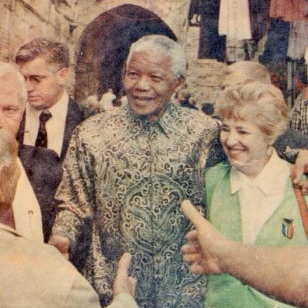
SA

Mandela’s trip to Israel showed his true passion for peace
JULIE LEIBOWITZ
This visit is important to the Jewish community because it showed just how much Mandela lived for being a peacemaker. His reason for visiting was to see how he could further enable peace between Israelis and Palestinians.
Whether it was finding peace with his past oppressors or present enemies; or negotiating for peace on the global stage, Mandela was committed to solving things peacefully, and approached every situation with humanity.
“I once asked him why he wasn’t bitter,” says Marlene Bethlehem, the former chair and past president of the South African Jewish Board of Deputies (SAJBD). She is currently the president of the Memorial Foundation for Jewish Culture in New York. “He told me: ‘If I behaved like them [the people behind apartheid], I would be no better than them.’ He was a great human being – with the accent on human.”
Together with the late Russell Gaddin, who was chair of the SAJBD at the time, and the late Cyril Harris, the then chief rabbi, Bethlehem met Mandela at the King David Hotel in Jerusalem, following his trip to Iran, Jordan and Syria.
He was in the region to promote peace. He chose to visit Israel at that time, following the election of Ehud Barak as prime minister, because he believed that Barak and the Israeli Labour party were more committed to the peace process than the previous regime under Benjamin Netanyahu.
“Mr Mandela had received and rejected at least four previous invitations to visit Israel since 1994, and his decision to come now was a clear endorsement of Mr Barak’s revived peace efforts,” The New York Times reported at the time.
He crossed the Allenby Bridge that connects the West Bank and Jordan, and met the SAJBD group at the hotel. “The most beautiful thing happened when we arrived,” she recalls. “Mandela said: ‘My rabbi is here. Now I feel at home in Jerusalem.’” He was referring to Harris, with whom he had a close relationship.
The group had lunch at the presidency with President Ezer Weizman, after which Mandela laid a wreath containing the South African flag at the late prime minister Yitzhak Rabin’s grave. From there, it was a short walk to the Yad Vashem Holocaust Museum. But the walk involved many steps, and Mandela was having trouble with his knee.
As Bethlehem describes it, he went slowly down the steps, accompanied by his physiotherapist, only to encounter a number of children at the entrance to the museum. “Mandela told them: ‘It is wonderful to see you all here. Only by visiting this sacred place will we make sure [the Holocaust] never happens again.’
“We know that Mandela had a great affinity with children,” she says. “As he was shown around Yad Vashem, suddenly we couldn’t find him. Eventually, we found him rooted to the spot in the complete darkness of the children’s section of the museum, where a candle is mirrored infinitely, representing the murder of more than a million children in the Shoah. He stayed there for ages. He seemed overcome with emotion.”
The next day, the team was required to smooth diplomatic feathers after Mandela wasn’t able to visit the Kotel due to his ailing knee. “The deputy director of foreign affairs phoned Gaddin. He was furious, saying: ‘Your Mandela won’t go to the Kotel!’ But how could Mandela have visited the Kotel, and not the Dome of the Rock or the Via Dolorosa at the same time?”
He did, however, manage to drive to the Stations of the Cross, which were important to him as a devout Methodist. “He could not do many of the stations because of his knee, but it was poignant to see Israel’s deputy director of foreign affairs explaining the Stations of the Cross to Mandela,” Bethlehem says.
On the way back, he put his arm around Bethlehem. The encounter was snapped by an entourage of photographers, who referred to her as “an identified South African tourist”. Bethlehem jokes that the incident came up in a later meeting with Mandela at which he said: “Marlene, do you recognise me?” To which she answered: “Madiba, I was the unidentified person, not you!”
Thereafter, Mandela visited Barak, and travelled to Gaza. The content of his talks with the prime minister weren’t disclosed to the South African delegation.
Bethlehem mentions that during his visit to Iran, Mandela even went as far as making enquiries about the famous missing Israeli soldier, Ron Arad, on behalf of his family, informing the delegation that Iran had no knowledge of his whereabouts. It wouldn’t be the first time he had interceded on behalf of individuals who were kidnapped and held for ransom.
“He was good at solving problems, but above all, he was a peacemaker,” she said, referring to the fact that later on, he managed to prevent South Africa from selling an important military weapon to Syria after the SAJBD interceded, advising him that it would be used on Israel. “Then vice-president Al Gore arrived a couple of months later, and wanted to talk to him about it. He said: ‘Don’t worry, I have already spoken to the Jews.’ The weapon was never sold.
“I think about Mandela on Mandela Day,” Bethlehem continues. “I love it because the whole world is sharing thoughts of his memory. Ultimately, to be in office at the same time as Madiba was the greatest privilege of my career.”




